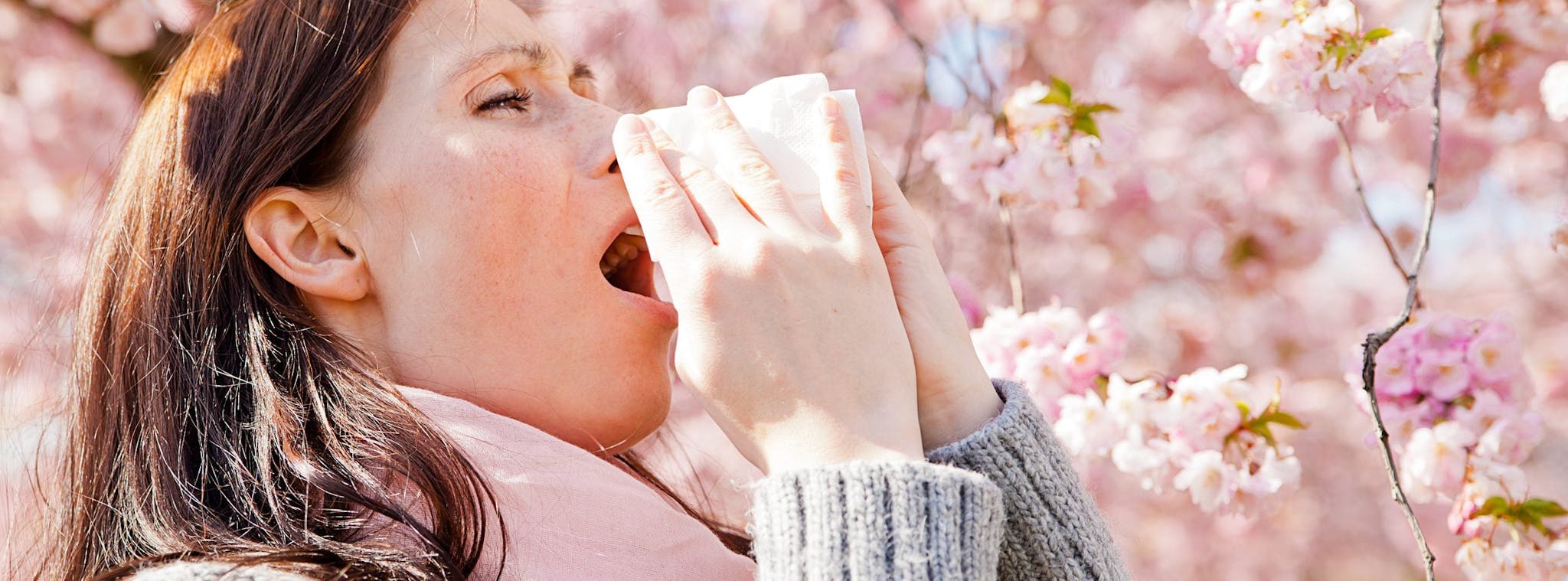
2024-07-12T16:54:51
Sunscreen Travel Tips
- Dermatology
April 26, 2016 | Allergy and Immunology

Although you enjoy a deep appreciation for the amazing natural world around us, do you also find yourself dreading the changing of the seasons? Perhaps as soon as the daffodil and crocus start to peek out from the warm spring soil, you come down with a throbbing headache that no amount of over-the-counter pain or allergy medications can relieve.
Maybe your eyes turn bright red as reliably as the arrival of the summer solstice, or your autumn “head cold” is as predictable as the turning of the leaves. What’s behind your symptoms that feel like a cold virus but seem to be more of a reaction to the natural environment surrounding you? Chances are good that you are one of the 55 percent of people in the United States who test positive to one or more allergen, according to WebMD.“]
These three most common triggers of seasonal allergies can affect you nearly year-round, depending on your personal set of irritants. The American College of Allergy, Asthma & Immunology explains that spring allergies can begin as early as February in some parts of the United States if mild winter temperatures cause plants to pollinate early.
Pollen is a very fine powder that is released from the stamen of flowering plants, carried through the air, and then inhaled, coming in contact with your nasal passages. We call an allergic reaction to pollen “hay fever.” Symptoms include:
Sneezing, nasal congestion, runny nose
Hoarse voice, sore or itchy throat
Coughing, wheezing
Headaches
Asthma
Watery, irritated eyes
Seasonal allergic conjunctivitis (SAC) is the most common type of eye allergy that usually develops in spring, lasting through autumn. Grass pollens cause SAC symptoms in May and June, while ragweed problems trigger eye allergies in August and September. You may notice chronic dark circles under your eyes from the pooled blood caused by your sinus and nasal congestion. Puffy eyelids, itching and sensitivity to bright lights are also possible.
If you have a pollen allergy, you may notice it flares up at different times of year, based on the specific blooming plants, trees, weeds and grasses in your region. Spring-blooming offenders include cedar, oak, birch and pecan trees, while reactions in the summer are usually due to grass pollens and fall brings weed allergies. An allergist can test you to determine exactly which pollens affect you.
Pollen, grass and mold are the 3 most common triggers of seasonal allergies, and can affect you nearly year-round, depending on your personal set of irritants.
A rainy spring can encourage rapid plant growth and lead to an increase in mold. Molds grow quickly in high humidity and heat, often extending your mold sensitivity well into the fall. Molds enter your home through open doors and windows where they grow on fabrics, walls, woods and blinds. They thrive in damp rooms and can be difficult to eradicate from your home without a consistent effort to keep bathrooms, basements and kitchens clean and well aired.
The most common culprit for fall allergies is ragweed, a wild plant that blooms and releases pollen from August to November. Ragweed is especially prevalent on the East Coast and in the Midwest. Ragweed and grass pollens thrive during cool nights and warm days. WebMD reports “ragweed pollen season has increased by four weeks over the last 10 to 15 years, likely as a result of global warming.”
Moving to a new geographical location is usually not a lasting solution for combating seasonal allergies because allergens are everywhere. You can’t avoid an irritant, but you can lower your exposure factor to reduce symptom triggers.
Check pollen and mold counts before you plan outdoor activities, and avoid spending time outdoors during the morning when pollen counts are highest.
Wear sunglasses and a mask if you must do yard work during pollen season.
Change your clothing when you come indoors, and shower and wash your hair.
Close your home and car windows, and use air-conditioning.
Don’t allow outdoor pets on your furniture.
Are you tired of suffering from seasonal allergies? Effective treatments are available. Revere Health Allergy and Immunology providers have over 30 years of combined experience and specialized training in diagnosing and treating nasal, sinus and ocular allergies, including hay fever. We serve pediatric and adult patients in two Utah locations, using the most comprehensive and up-to-date medical therapies.”]
WRITTEN BY:
The Live Better Team


2024-07-12T16:54:51

2024-07-02T11:42:04

2024-07-01T13:49:28

2024-06-21T14:29:51
This information is not intended to replace the advice of a medical professional. You should always consult your doctor before making decisions about your health.